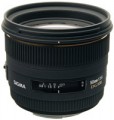DxOMark rating
The result shown by the lens in the DxOMark rating.
DxOMark is one of the most popular and authoritative resources for expert testing of photography devices. According to the test results, the lens receives a certain number of points; The more points, the higher the final score.
Mount
The type of mount used to connect the lens to the camera. The name comes from the English "bayonet", meaning "bayonet" and a bayonet-type connection. Bayonet mounts are used in the vast majority of modern digital cameras due to their reliability and ease of use.
Full compatibility of the lens with the camera is guaranteed only if the types of their mounts match. Some mounts are compatible with each other via adapters, but such a connection can limit the capabilities of the lens (for example, it will make it impossible to use autofocus) and is generally not considered optimal. It is worth considering that within the same system (see above) different mounts are often used, which are also incompatible with each other.
So, the manufacturer Canon has mounts
EF-M,
EF-S,
EF,
RF,
RF-S. Leica has
Leica M,
Leica SL,
Leica TL. Nikon has
Nikon 1,
Nikon F,
Nikon Z in its arsenal. Pentax optics are equipped with
Pentax 645,
Pentax K,
Pentax Q. Samsung uses
NX-M and
NX mounts. Sony models include
Sony A and
Sony E. In addition, there are other types of mounts on the market - both branded (
Fujifilm G,
Fujifilm X,
Hasselblad H,
Sigma SA) and universal (
Four Thirds (4/3),
Micro 4/3).
Note that there are lenses that are declared compatible with several mounts at once. This “omnivorousness” can be realized in different ways. For example, some models have a non-standard mount on the lens body, and compatibility with various mounts is ensured through the use of adapters; These adapters can be included in the delivery set or purchased separately. Another option is that the lens is available in several separate modifications, each for its own mount. These details should be clarified before purchasing.
Viewing angles
This parameter determines the size of the area of the scene being shot that falls into the frame. The wider the viewing angles, the larger the area the lens can capture in one shot. They are directly related to the focal length of the lens (see "Focal length"), and also depend on the size of the specific matrix with which the optics are used: for the same lens, the smaller the matrix, the smaller the viewing angles, and vice versa. On our website, in the characteristics of optics, viewing angles are usually indicated when used with the matrix for which the lens was originally designed (for more details, see "Matrix Size").
Minimum focus distance
Minimum focus distance (m) - the smallest distance from which you can focus on an object and take a photo. Usually it ranges from 20 cm for wide-angle lenses to several metres for telephoto. In the macro mode of the camera or with the help of macro lenses, this distance can be less than 1 centimeter.
Maximum zoom
The degree of magnification of the object being shot when using a
lens for macro shooting (that is, shooting small objects at the maximum possible approximation, when the distance to the subject is measured in millimetres). The degree of magnification in this case means the ratio of the size of the image of the object obtained on the matrix of the camera to the actual size of the object being shot. For example, with an object size of 15 mm and a magnification factor of 0.3, the image of this object on the matrix will have a size of 15x0.3=4.5 mm. With the same matrix size, the larger the magnification factor, the larger the image size of the object on the matrix, the more pixels fall on this object, respectively, the clearer the resulting image, the more details it can convey and the better the lens is suitable for macro photography. It is believed that in order to obtain macro shots of relatively acceptable quality, the magnification factor should be at least 0.25 – 0.3.
Design (elements/groups)
The number of elements (in fact, the number of lenses) included in the design of the lens, as well as the number of groups in which these elements are combined. Usually, the more elements provided in the design, the better the lens handles with distortions (aberrations) when light passes through it. On the other hand, numerous lenses increases the dimensions and weight of the optics, reduces light transmission (for more details, see "Aperture") and also puts forward increased requirements for the quality of processing, which affects the cost of the lens.

